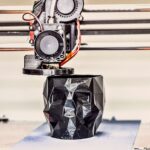I. Introduction to 3D Printed Adapters for Vintage Camera Lenses
II. Benefits of Using Vintage Lenses on Modern Camera Bodies
III. How to Find or Create Custom 3D Printed Adapters
When it comes to photography, there’s something undeniably charming about vintage camera lenses. These gems from the past offer unique character and aesthetics that are often hard to replicate with modern glass. However, as technology continues to advance, many photographers find themselves wanting to use these classic lenses on their sleek new digital cameras. Enter the world of 3D printed adapters—a game changer for vintage lens enthusiasts!
Why 3D Printed Adapters?
So, you might be wondering, what exactly are 3D printed adapters? Simply put, they are custom-made components designed to allow vintage lenses to attach to modern camera bodies. The beauty of 3D printing lies in its ability to produce highly specific designs tailored to the exact specifications of both the lens and the camera. This means you can maintain that retro vibe while utilizing the advanced features of your current gear.
Unlocking Creativity and Versatility
Using vintage lenses on modern cameras opens a whole new world of creative possibilities. Here are a few reasons why you should consider this exciting combination:
- Unique Aesthetic: Vintage lenses often have distinct optical qualities, such as soft focus and beautiful bokeh, which can give your images a timeless feel.
- Character: Many vintage lenses exhibit unique flare and color rendition, making your photographs stand out in a sea of digital perfection.
- Affordability: High-quality vintage lenses can often be found at reasonable prices, making them an accessible option for photographers looking to expand their toolkit.
The Technical Side
Now, let’s talk about the technical aspect of using these adapters. A well-constructed 3D printed adapter can offer a seamless fit, ensuring that your lens remains securely attached to your camera. This is crucial not only for stability but also for maintaining the integrity of your images. The precision of 3D printing technology allows for tailored designs that match the specific mounting systems of different cameras and lenses.
Environmentally Friendly Option
Another noteworthy advantage of 3D printed adapters is their environmental impact. Traditional manufacturing methods often entail wasteful processes, but 3D printing is generally more sustainable. You can create just what you need, reducing excess production and material waste. Plus, many 3D printing services now offer biodegradable materials, making this an eco-friendly choice!
Where to Start
If you’re new to the world of 3D printing, don’t worry! There are numerous resources and communities dedicated to helping enthusiasts create their own adapters. Websites like Thingiverse and MyMiniFactory host an array of 3D models that you can download and print. Additionally, there are online forums and groups where you can connect with fellow photographers who can provide guidance and support.
In conclusion, 3D printed adapters for vintage camera lenses are not just a practical solution; they are a wonderful bridge between the past and present in photography. By combining the timeless appeal of vintage glass with modern technology, you can unleash a wave of creativity in your photography. So, grab that old lens sitting in your attic, and let’s explore the exciting possibilities together!
Benefits of Using Vintage Lenses on Modern Camera Bodies
Hey there, photography enthusiasts! If you’re anything like me, you’ve probably spent hours scouring through old camera shops or trolling online marketplaces, searching for those beautiful vintage lenses that once captured the world in a completely unique way. You might wonder, why would anyone want to use these classic pieces of glass on a modern camera? Well, let me share with you some fantastic benefits of using vintage lenses on your current gear!
1. Unique Optical Characteristics
One of the most significant advantages of vintage lenses is their distinct optical characteristics. Unlike many modern lenses that prioritize sharpness and contrast, vintage lenses often offer a softer, dreamier look. This can be particularly appealing for portrait photography or artistic shots where you want to evoke emotion rather than just clarity.
- Beautiful Bokeh: Vintage lenses are renowned for producing stunning bokeh. The out-of-focus areas can have a unique swirl or softness that adds character to your images.
- Color Rendition: Many vintage lenses have a color rendition that differs from modern lenses, often resulting in warmer tones or vibrant colors that can make your photos pop with personality.
2. Build Quality and Aesthetic
Have you ever held a vintage lens in your hands? The weight, the texture, and the solid feel can be incredibly satisfying. Unlike many plastic modern lenses, vintage counterparts often feature all-metal builds that can withstand the test of time. They not only perform well but also look amazing on your camera.
Plus, there’s something undeniably charming about vintage gear. Using a classic lens can turn heads at a photoshoot and spark conversation. It’s like carrying a piece of history while you create your own!
3. Affordability
Let’s face it; high-quality modern lenses can be quite pricey. Vintage lenses, on the other hand, can often be found at a fraction of the cost! This means you can experiment with different focal lengths and styles without breaking the bank.
- More for Less: By investing in a few vintage lenses, you can expand your photography toolkit significantly while keeping your budget intact.
- Collectibility: Some vintage lenses are rare finds, which can make them both affordable and collectible. You might stumble upon a hidden gem that appreciates in value over time!
4. Learning Experience
Using vintage lenses can also be a fantastic learning experience. Many of these lenses lack the modern conveniences of autofocus and image stabilization, encouraging you to dive deeper into the art of manual photography. You’ll become more aware of your settings and composition, ultimately improving your skills.
Moreover, experimenting with different vintage lenses can teach you how various focal lengths and apertures affect your images, giving you invaluable knowledge that can enhance your overall photography journey.
5. A Connection to the Past
Finally, using vintage lenses can create a unique connection to the past. Each lens has its own story—who used it, what moments it captured, and how it has survived through time. By incorporating these lenses into your photography, you’re not just taking pictures; you’re continuing a legacy.
So, whether you’re a seasoned pro or just starting, consider giving vintage lenses a try! With their unique qualities and appealing aesthetics, you might find that they become a beloved part of your photography adventures.
How to Find or Create Custom 3D Printed Adapters
If you’re eager to dive into the world of vintage lenses but find yourself stumped on how to attach them to your modern camera body, fear not! The magic of 3D printing comes to the rescue. Whether you want to buy a ready-made adapter or create a custom one, the process can be surprisingly easy and fun. Let’s explore your options!
Finding Ready-Made Adapters
First off, if you’re not quite ready to take on the challenge of creating your own 3D printed adapter, there are numerous places where you can purchase them. Here are a few tips to help you on your search:
- Online Marketplaces: Websites like Etsy or eBay often have sellers offering various 3D printed adapters. Just make sure to check the reviews and product descriptions to ensure compatibility with your specific lenses and camera model.
- Photography Forums: Communities such as Flickr or dedicated photography forums often have members who either sell or can direct you to reliable sources for 3D printed adapters.
- Social Media Groups: Don’t underestimate the power of social media. Joining photography groups on platforms like Facebook can connect you with people who have experience with vintage lenses and might have recommendations for adapters.
Creating Your Own Custom Adapter
If you’re a bit of a DIY enthusiast (or just love the idea of customizing your gear), creating your own 3D printed adapter can be a rewarding project. Here’s how you can get started:
- Research the Specifications: Before you dive into designing your adapter, you need to know the specifics. Measure the dimensions of your vintage lens and the mount of your camera body. Precise measurements are key to ensuring your adapter fits perfectly.
- Choose Your Design Software: There are several user-friendly 3D modeling tools available, like Tinkercad or Blender. Tinkercad, in particular, is great for beginners and offers a simple drag-and-drop interface.
- Find Existing Designs: If designing from scratch feels daunting, check out platforms like Thingiverse. You might find a pre-existing design that suits your needs! You can modify it as necessary to ensure a snug fit.
- Print it Out: Once your design is ready, it’s time to print! If you don’t own a 3D printer, you can use services like Shapeways or Sculpteo that will print your design and ship it to you. Make sure to choose a durable material that can withstand the stress of attaching and detaching lenses.
Final Thoughts
Whether you opt to purchase a ready-made adapter or embark on the creative journey of designing your own, the world of 3D printed adapters for vintage lenses is full of possibilities. Not only will you enjoy the unique character of vintage glass, but you’ll also have a customized solution that enhances your photography experience. Happy shooting!




Comments